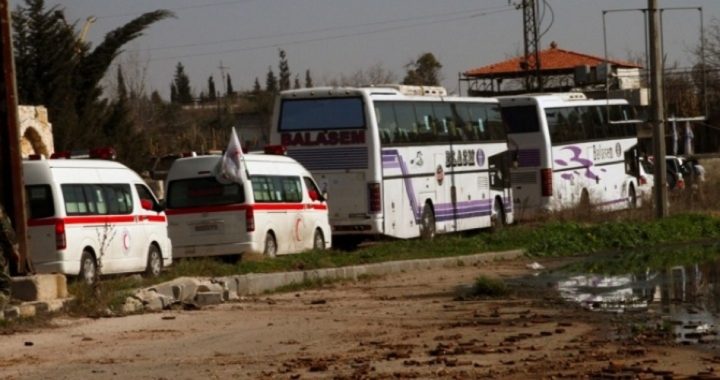
The first groups of civilians were evacuated on February 7 from rebel-held sections of Homs, a war-ravaged city in western Syria that has been a major battleground between government and rebel forces in Syria’s civil war. The evacuation is considered to be a positive result stemming from the UN-backed Geneva II Conference on Syria held from January 22-31.
The Washington Post reported that the agreement reached after the first round of negotiations at Geneva II could pave the way for a second round, which is due to begin next week. The Syrian government on Friday confirmed that its representatives would attend.
The Jersualem Post reported that Homs governor Talal al-Barazi said when the deal was announced that the first group of evacuees from Homs would include children under 15, men over 55, and women. While reception centers had been set up to receive and treat people leaving the old city, those evacuated were free to go wherever they wanted.
“We are ready today to receive any number, even it exceeds 400, but according to the United Nations yesterday the expected number is 200, or it could be lower,” al-Barazi told Syrian television.
“We hope this first step will succeed and will continue tomorrow and after tomorrow and so on to ensure safe exit to all civilians who want to leave the old city.”
State Department spokesperson Jen Psaki said during a press briefing in Washington on Thursday:
We welcome the news that a deal has been reached between the opposition forces inside Homs and the region — and the regime, which would allow humanitarian access into Old City of Homs and allow evacuations of those civilians who want to do so. We understand the operations will begin tomorrow, Friday morning, and will include a local humanitarian pause while the evacuations take place and while the food and other humanitarian assistance is delivered.
Ms. Psaki was emphatic about not giving the Assad government any credit for allowing the evacuation or providing food for the evacuees, however. She stated:
As we have said, an evacuation is not a substitute for the safe, regular, and unfettered delivery of humanitarian assistance to those in need wherever they are….
Civilians are leaving their homes in Homs because they are in desperate need of food and medical attention. It is a tragedy that they should feel that they have to abandon their homes and split up their families just to eat and get care. This issue should never have been a problem in the first place….
So we should not be giving credit to a regime just for providing food for a few days to people who are starving, given that’s the right moral thing to do and this is something they should have been doing all along.
Trying to find the villains responsible for the suffering in Homs is a difficult assignment, since both sides have conducted military operations to gain control of the city. In February 2012, Syrian government forces carried out a major attack on Homs to take back control of the city from the Free Syrian Army, which had established a major operations center there.
Most major media reports portray the Free Syrian Army as a group of patriots fighting to overthrow a regime that is evil incarnate, but the leading rebel group is by no means free of radical influences.
For example, a Washington Post report on January 30, 2012 noted:
Syrian opposition leaders report an alarming growth within their ranks of fighters from Jabhar al-Nusra, an extremist group linked to al-Qaeda…. the al-Qaeda affiliate now accounts for 7.5 percent to 9 percent of the Free Syrian Army’s total fighters, up sharply from an estimated 3 percent three months ago and 1 percent at the beginning of the year.
In an article posted by The New American last September 17, “What is the Obama-backed Free Syrian Army?,” Alex Newman answers the question posed in the title: “No two analysts have the same answer.”
However, this much is agreed upon by most analysts of the Syrian civil war: “It is dominated by Islamists, including the Muslim Brotherhood and various other hardline Salafist groups known for violently seeking sharia law and strict enforcement of their interpretation of Islamic doctrine.”
Newman quoted from a report from NBC News that stated:
While the U.S. already is providing money, equipment, training and limited weaponry to the Free Syrian Army (FSA), some U.S. military officials are growing increasingly concerned about the presence of extremist Islamic groups within the overall force. A U.S. military strike, even a limited one, could tip the balance in the civil war in favor of the rebels, they argue, potentially propelling these or other radical Islamic groups into a position of power in a post-Assad Syria.
An anonymous senior U.S. military official cited by NBC said that Pentagon officials estimate that extreme Islamist groups now constitute “more than 50 percent” of the rebel force, “and it’s growing by the day.”
Newman wrote that “despite claims of moderation by Western supporters, self-styled Free Syrian Army fighters and groups have been implicated in more than a few atrocities — many of which, such as executing captured prisoners without due process, constitute clear war crimes. Most recently, the FSA worked with the al-Qaeda affiliated al-Nusra front and the jihadist Ahrar al-Sham group to seize control of the ancient Christian town of Maaloula — one of the few remaining places on Earth where Aramaic, the language of Christ, is still spoken.”
With a record like that, it is hard to place all the blame for the hunger and other afflictions suffered by Homs’ residents on government forces. Even if Assad is as bad as portrayed by much of the Western media, the rebels who also occupied Homs must share in the blame for their plight. The people of Homs are no better off than the people of Poland were when their country was jointly invaded and occupied in 1939 by troops from Hitler’s Germany on the west and Stalin’s Soviet Union on the east.
Following Hitler’s abrupt decision to turn on the Soviets, the United States aided the Soviet Union throughout World War II. Fast forwarding to the present, U.S support for the jihadist rebels, many of whom are affiliated with the al-Qaeda terrorist organization, indicates that our government again shows little compunction about backing a force it arbitrarily deems to be the “lesser of two evils.”
In light of this, Ms. Psaki’s obviously partial statements portraying Assad’s forces as the sole villains in the war that has brought so much suffering to the people of Homs do little to enlighten outsiders about the true nature of this terrible situation.
Photo of two buses of evacuees from Homs followed by Syrian Arab Red Crescent vehicles: AP Images
Related articles:
Peace Talks on Syria Get Off to Tense Start in Switzerland
What is the Obama-backed Free Syrian Army?
Rebel Atrocities in Syria Escalate, Sparking Alarm Over Obama Plan



